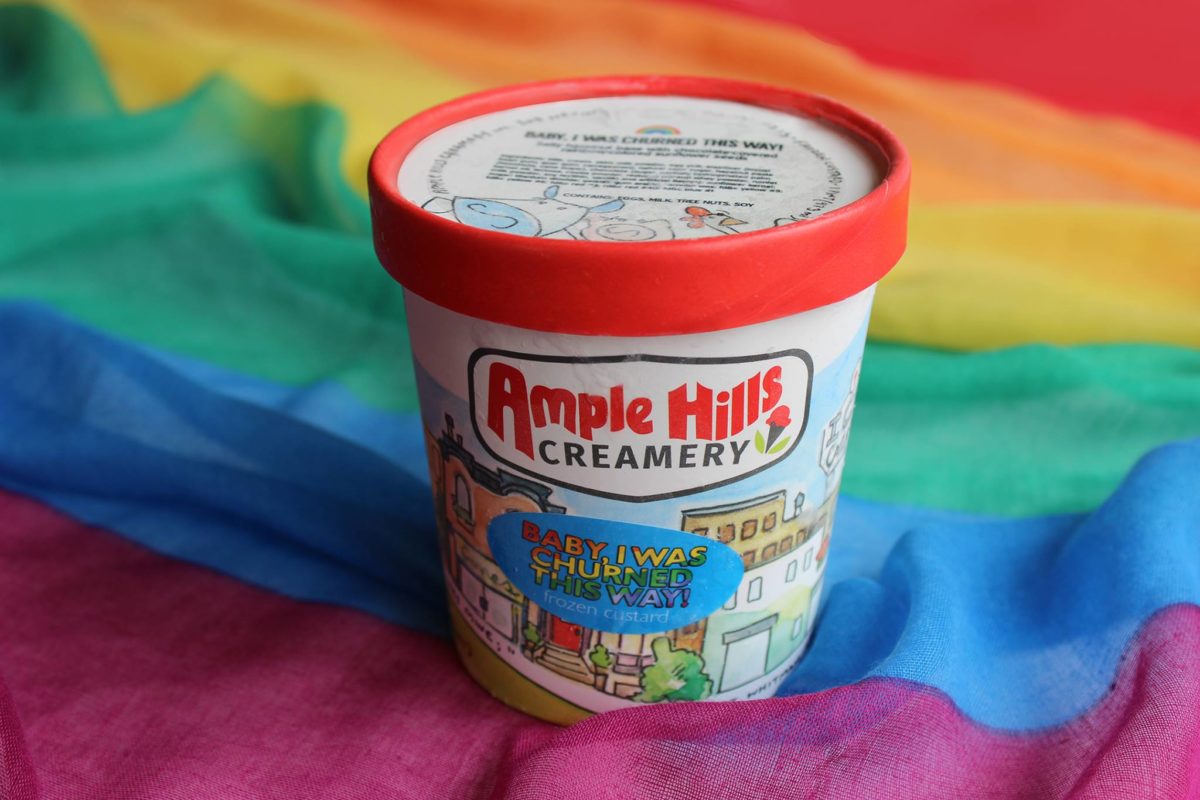Skift Take
When you have a vision to take your business to the next level, it doesn't hurt to be able to model it after one of the biggest successes in the industry.
— Kristen Hawley
Ample Hills Creamery Inc. is known around New York for its indulgent, over-the-top ice creams such as Salted Crack Caramel and Chocolate 3 Ways. Around the country, it’s recognized as the official ice cream of the Star Wars film franchise, and whose limited-edition Dark Side and Light Side flavors, released in conjunction with The Force Awakens, sold 40,000 pints online.
Brian Smith, co-founder of Ample Hills, produced all of that Star Wars ice cream from a 900-square-foot facility. Now, as he works on new flavors for The Last Jedi, he’s opening a 15,000-square-foot factory in Brooklyn and a new flagship store in L.A., and gearing up for ice cream’s biggest challenge: to become the next Ben & Jerry’s.
Before he began selling scoops at the first Ample Hills in a residential Brooklyn neighborhood in 2011, Smith was a science-fiction screenwriter with a side obsession. “I absolutely love making ice cream,” he says. He and his wife, Jackie Cuscuna, fashioned their store on the small neighborhood shop Cuscuna grew up visiting—Eddie’s Sweet Shop in Queens, an ice cream parlor that’s been open for 108 years.
By the time they’d opened their second store, Smith had determined he wanted to be the next Ben & Jerry’s. In 2015, on a road trip to Vermont with Cuscuna (now Ample Hills CCO, or chief culture officer), he met the actual Jerry Greenfield, who gave them some key advice: Concentrate on pints of ice cream, not stores. Virtually all Ben & Jerry’s stores are franchises.
The Ben & Jerry’s brand is inspiration for many food businesses. In 1978 the founders struck on the ice cream idea because it was easy to make; then they added chunks and swirls and danced their way to artisanal food history. In 2000, B&J sold to Unilever for about $326 million. Today the brand has annual revenue upwards of $1.23 billion, which is still $1 billion less than Häagen-Dazs (now owned by Nestlé). Talenti, another artisan ice cream brand, sold to Unilever in 2014 for an unreported amount, but its revenue at that time was $120 million. Smith admires Talenti, but doesn’t think it’s in the same ballpark as Ample Hills. “Their ice cream is good, it’s perfectly fine, but nothing makes it stand out other than the container,” he says.
A New Home
Ample Hills expects to pull in $7.5 million this year, a relatively small number in the snack food world. To get Unilever big—without selling out—Smith needed a factory. In spite of the notorious rents, he decided to stay close to home in Brooklyn. (He sees the area’s worldwide reputation as a competitive advantage.) Eventually he found a location in an historic building in Red Hook. At capacity, the 15,000-square-foot factory will produce about 1 million gallons annually. It will be the only ice cream plant of that size in all five boroughs of New York City when it opens in late September.
The vast space will include a scoop shop with viewing windows to the Willy Wonka-style action: The bakery, where they handmake everything, will spit out Rice Krispie clusters, brownie bits, peanut butter cups, and dark chocolate peppermint patties; and the dairy floor will churn out the ice cream flavors.
“I’ve always been interested in that way that ice cream can transport you back in time to that joy of discovery that we lose as adults,” Smith says. To that end, he invents flavors that capture the imagination of his 7-year-old self, like Open Face, his attempt at remaking the classic cookies ’n’ cream with Ample Hills’ own double-stuffed “Oreos” mixed into a sweet cream base. He has even come up with scoops to commemorate the recent presidential election: The Trump flavor was Make America Orange Again, a creamy orange-marshmallow concoction that was not an unmitigated hit. And in 2015 he began his ongoing collaboration with Disney on limited-edition Star Wars flavors.
The Force Is With Them
When Star Wars: The Last Jedi comes out in theaters on Dec. 15, it will be heralded by two new special Ample Hills flavors. Smith hasn’t finalized them yet but promises that he will be weaving the factions and themes of the new movie into the final pints. (He says it will be a different direction than the Dark Side and Light Side pints for The Force Awakens.) “We start with the story, and then we think about flavor to support [it],” he says.
Ample Hills’ connection to Disney goes beyond the Star Wars franchise. One day early in the company’s history, Smith spotted Bob Iger’s name on his e-commerce order sheet. It was a short list: Not many people order ice cream online. “Iger, the CEO of Disney, must love ice cream,” Smith thought. He had his artist, Lauren Kaelin—who is responsible for the murals in his stores—draw up an image of Mickey Mouse wearing an Ample Hills T-shirt. They sent it off with six pints of ice cream and some dry ice.
It was a hit. Iger emailed Smith with the message that he thought the ice cream was great. Iger ended by writing, “If you ever want sage advice from a guy who’s been in business for a long time, feel free to get in touch.” For Smith, it was surreal. “Your jaw drops and you say, ‘Is this really Bob Iger?’ ” He emailed right back: “Bob, I could use some advice.”
It was a pivotal moment for the Ample Hills owner, who was deciding whether to grow big or stay small. “There’s something inherent about growth that turns people off. We’re thinking philosophically of how to build a chain that doesn’t feel like that and is connected to its origins,” he says.
The relationship between Ample Hills and Iger flourished. “I gave everyone ice cream. By the way, I don’t eat much ice cream,” Iger said in a phone interview. “Everyone thought I had lost my mind.” He sent pints to Jimmy Kimmel, Mike Nichols, J.J. Abrams, Tom Hanks, Oprah. Everyone reveled in Iger’s new sweet tooth.
Iger and Smith have been talking for well over three years now. Among the many pieces of advice Iger passed along was not to sell a big chunk of Ample Hills to a single investor early on, and to keep the new factory in Brooklyn, even if it cost more. “I told him that I thought he should [stay in Brooklyn] because he could manage it more carefully,” Iger said.
“I have the luxury of collecting a lot of wisdom from business decisions, not that all of it is applicable to an artisan ice cream shop. [Yet] it’s been nice to impart that wisdom to someone I like so much, and to help a high-quality product thrive.”
Iger is not an investor in Ample Hills, but he does admit to having regular helpings of the stuff, including, of course, the Star Wars flavors. “I allow myself four spoons a week. There’s always Ample Hills around: Crack Caramel, Ooey Gooey Butter Cake. I love the Star Wars. I was a big fan of the Gilmore Girls flavor [coffee and chocolate pudding ice cream with pink pop tarts]. Not the show but the ice cream.”
West Coast Expansion
Smith’s push for ice cream dominance comes at a tricky time. The sector is growing by only a minute fraction—1 percent annually. While there is growth, it’s coming from rising prices, not increased consumption. According to Euromonitor International, the biggest obstacle in the ice cream industry is that fickle thing known as consumer demand; Americans are simply not eating as much ice cream as they used to. Blame it on kale.
In May 2016, Smith opened his then-seventh location at Walt Disney World in Florida. This summer he opened in Brooklyn’s DeKalb Market Hall, and soon will open on the waterfront in Jersey City, which will be his ninth location. But with this speedy growth comes reflection. Much of the advice the owners received was to look for a manufacturing partner instead of opening their own factory. But if they did that, Smith felt they would lose their story.
“People love Ample Hills because they feel connected to the brand,” he says. “We’re a mishmash of a lot of different things—how fragile is that? If we take away the roots and make it somewhere else …” His voice trails off. Smith explored this tension further in an episode of Material World on “craft” last May.
In addition to the factory, the scoop shops, and growing sales on Amazon, the team is working on a Los Angeles-area shop—a 2,200-square-foot flagship in Los Feliz—to open in 2018. They’re also in the process of creating new pint containers that will look unlike any other brand on the shelf. The shape riffs on retro rectangular-shaped pint containers and will include spoons that snap into the lid. Along with this last step, and the scale of the factory, Ample Hills will be able to seek nationwide distribution on par with the other big players.
Series A Fundraising
To go from nine shops to, say, 577, which is the number B&J has worldwide, Smith is planning a Series A round this fall for $8 million. The money will help Ample Hills create experiential stores around the country. Think event spaces for ice cream parties, bikes that churn the frozen treat, and even classes for the dessert-inclined.
That investment, plus the new Red Hook factory, will allow not just scale, but also better ice cream.
Right now Smith buys pasteurized milk and cream, which means it’s already heated once before they have to heat it again to turn it into ice cream. With the factory, they can buy raw milk in 300-gallon totes. “We’ll cook it once, and the quality will be much better. We’ll have a fresher product and we’ll homogenize the mix, which makes it smoother. You want every scoop of Ooey Gooey to be the same,” says Smith, referring to his creamy vanilla ice cream made with hunks of homemade St. Louis-style butter cake. “Right now it’s impossible. People stand at the ice cream maker and stir it in—some people have a heavier hand,” he says. (Believe it or not, sometimes people complain about too much of a mix-in.) In the new factory, pieces of Ooey Gooey will be fed into a tunnel, which then goes into the ice cream.
Smith and his wife still remember the early times when they had to close their first shop after being open only three days (they had run out of ice cream). And well before they had a CFO, Smith would lug wads of cash to the bank each day in a brown paper bag. He never knew how much he had, but the bank account kept growing, and the company grew along with demand and “best of” accolades.
Cuscuna points to the day she and Smith met Ben & Jerry’s Greenfield on that Vermont trip. They sat with the co-founder for an hour and a half talking about the early days, the wholesale business, and routes for expansion.
“His advice validated what we had already decided on,” says Cuscuna. “They had quickly realized that they wanted to push the pints, the ethos is very similar to ours, and so are their pints, full of stuff and playful and whimsical.”
Iger is also pleased to see Ample Hills grow. He describes the advice he gives to Smith as a different way of giving back: “It’s altruism that has a side of really good ice cream.”
©2017 Bloomberg L.P.
This article was written by Larissa Zimberoff from Bloomberg and was legally licensed through the NewsCred publisher network. Please direct all licensing questions to [email protected].
![]()



